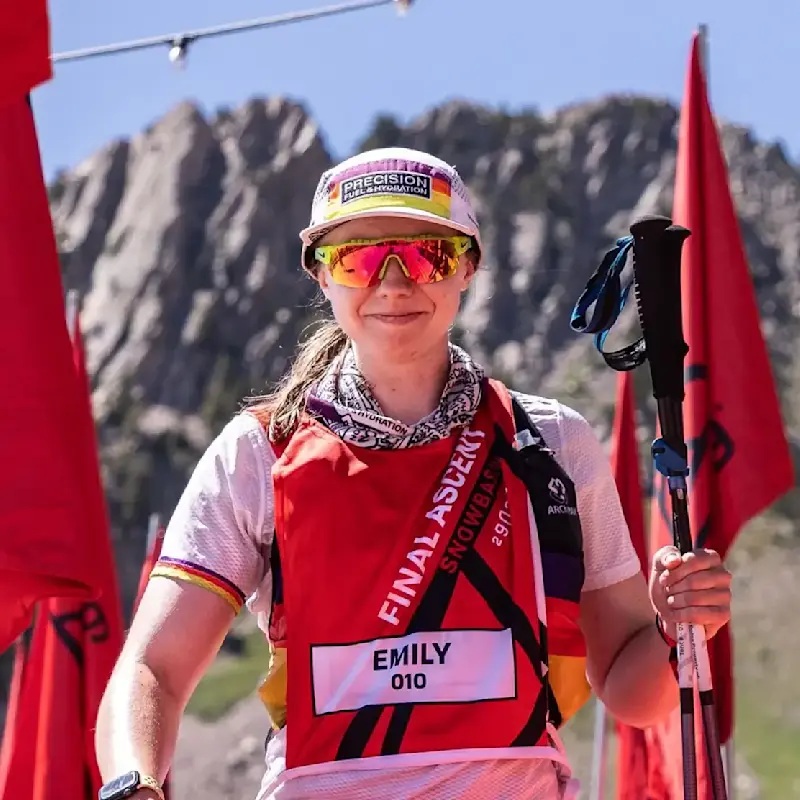
Emily Arrell
29029 Snowbasin
Emily's headline numbers
Emily's strategy
Fueling
Carbohydrate is the main fuel you burn when racing. Failing to fuel properly is a leading cause of underperformance in longer races.
As a member of the Sports Science Team, Emily practised what she preaches in the lead up to her first long endurance event. Before the race, this meant meeting the scientific guidelines for carb loading by consuming ~8.5g/kg of oatmeal, pasta, sweets, pastries, energy drinks and more the Thursday before the event. She then followed the recommendations for her final pre-event meal, taking on ~1.6g/kg 1.5 hours before the start.
Following the 29029 Fuel & Hydration Planner’s carbohydrate recommendation, Emily aimed to consume 60g/h whilst hiking the 13 ascents of Snowbasin (the stats above include her rest and gondola time). With the help of PF 60 Chew Bars, PF 30 Gels and PF 30 Chews all consumed on the move, she was able to stave off major energy dips and average 84 minutes for each ascent. With the unique ~15-minute gondola ride (typical of 29029 events), Emily tactically utilised this downtime to refuel with solid food, including energy bars and waffles, and she also took advantage of the three meal times where food was provided in the cabin. Overall, Emily averaged ~48g/h across the 29.5 hours she was out there, and closer to ~53g/h when discounting her three hours of sleep. When broken down by sections, her intake varied to match the demands; averaging ~64g/h for hikes 1-4, ~31g/h for hikes 5-7, ~51g/h for hikes 8-10 and then ~43g/h for hikes 11-13. Some fluctuation is expected in an event of such length, but the priority of consistent fueling remains. In this case, her large drop during hikes 5-7 was driven by changes in pace and subjectively by muscle discomfort. She brought her intake down during these hikes, which coincided with the hottest part of the day, as she didn’t feel her stomach would tolerate more.
Hydration
Taking on board an appropriate amount of fluid and sodium is essential to maintaining blood volume and supporting the cardiovascular effort needed to perform on race day.
Whilst the absolute amount of sodium and fluid consumed per hour is important, it’s critical to consider these in relation to each other. This is known as 'relative sodium concentration' and it’s expressed in milligrams per litre (mg/L). How much sodium you’re taking in per litre of fluid is more important than the absolute amount taken in per hour.
Sweat sodium concentration (mg/L) is largely genetically determined and remains relatively stable. Knowing how salty your sweat is enables you to replace a good proportion of your sweat losses, which can range from 200-2,000mg/L.
Whilst Emily’s losses are on the moderate side, getting her hydration strategy right is still crucial when it’s hot and/or humid as her higher sweat rate in these conditions can result in significant net losses over the duration of a race.
Learn moreUsing tips from previous 29029 finishers, including Chris from the Marketing Team, Emily decided to use a hydration pack, carrying two 500ml soft flasks throughout. To replace her moderate sweat sodium concentration, she used PH 1500 in one flask and plain water in the other, aware she would get additional sodium in her lunch, dinner and breakfast meals. This allowed her to match her sodium losses and avoid flavour fatigue from her drinks.
After weighing her empty soft flasks and wrappers to collect accurate data, Emily refilled both of her flasks at the bottom of the mountain before each ascent. This meant she could carry enough fluid with her to keep up with her total fluid losses (as measured in the Precision Performance Lab). As temperatures warmed throughout the day, so did her fluid demands. Emily wisely increased her fluid intake during these hikes and refilled again at the top aid station to sip alongside her real food on the way down.
Caffeine
Beyond the Three Levers of Performance (carb, sodium and fluid), caffeine is one of only a few substances that is proven to improve performance for most endurance athletes as it can help stave off mental and physical fatigue.
To avoid spikes and dips in levels of the stimulant, Emily chose not to have any caffeine until about halfway through the event. She had a cola with dinner at 7pm before using cola from aid stations during each of the night hikes (8-10) in an attempt to fight her body’s circadian rhythm and boost perceived energy levels. After a quick nap between 2-5am, she used a couple of cups of coffee as another strategic caffeine boost to help her finish the final few hikes. This put her within the scientific recommendations of caffeine usage, though on the lower end, indicating she could have reached for another few extra cups of cola or coffee when she noticed her energy starting to fall midway.
How Emily hit her numbers
Here's everything that Emily ate and drank on the day...
Emily's weapons of choice
Final thoughts
Emily's full stats
Data Confidence?
There is a high level of confidence in the accuracy in the data. The numbers presented are believed to be a very close reflection of reality. There may still be one or two estimations made in the data (an inescapable part of field data) but there is reason to believe that these are accurate and that possible error has been kept to a minimum. It is data that has been collected and recalled as accurately as is possible given the uncontrolled settings/circumstances.